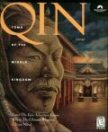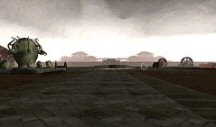Qin: Tomb of The Middle Kingdom
Pointers:
Adventure game (educational)
Point and click
First person
Puzzles
There are endless discussions about what a good adventure game is
and opinions are as varied as are the adventure players themselves.
There is seldom and agreement about the different parts of a game.
There are preferences of dialog, first or third person play,
linearity, game engine, 2D, 3D and the complexity of puzzles.
However one underlying truth always comes out of these discussions.
A good adventure game has an intriguing story, it takes us to
interesting and beautiful places, it allows us to explore it and
solve its mysteries. We like to do this without having to kill
someone or something, without gore and weapons. Some qualify a game
as Myst like or a Myst clone implying that this somehow is not a
compliment. This does not worry me. I like Myst like adventures and
I know that a lot of other adventure gamers do too as the sales
records of Myst, Riven and Myst III already showed this to us. I
also like educational games I do not mind learning new things or get
a new perspective on old ideas. Sometimes these “edugames” are more
like interactive books but if the subject matter is interesting I am
game. If you are interested in Chinese culture, literature, art and
archeological findings you are in your element, if you are not you
will be bored to death.
Story
Qin is exactly what its title describes: it is the exploration of
an underground necropolis the tomb that contains all that Qin Shi
Huangdi a great emperor of China had during his rein.
A Mega Media, an international conglomerate finances an
archeological expedition to locate a fabled buried city. The purpose
of this expedition is more than meets the eye, the financial giant
is looking for the “elixir of life” that is supposedly secreted
somewhere in this city.
You play an archeologist who is searching for this underground
city and find its entrance, by accident, during an earthquake.
Suddenly this new and exciting underground word is yours to explore.
You encounter works shops, stores, canals, gardens, palaces,
temples, they are colorful and authentic and very interesting to
explore. At the end you are called upon to make a very serious and
important decision that will govern the outcome of the game. It is
your call, do what you think is best.
Gameplay
There is an extensive and well-written manual. It not only
elaborates on the history of the Qin Empire but also gives detailed
information of the time of the game. The cursor is indicative:
objects can be picked up examined and manipulated. This is all well
explained in the manual.
Option Screen: Start/exit, game, save, help and adjusts
preferences form music on/off to cursor speed and brightness.
Navigation is either by keyboard arrows or by mouse clicking on
the arrows provided at the lower left screen, active direction shows
on an indicator at the lower right screen.
The Data Visor on the top of the screen gives access to:
The newsreader gives
contemporary news at the supposed time the adventure takes place.
The interpreter will
translate text and symbols in a separate small window on the screen.
Spoken Chinese will be simultaneously translated.
Maps: map of the current
realm can be accessed and the location indicator shows the player’s
position.
Transport nodes can take
you back to already visited places.
Archive contains the
Encyclopedia and the Room Index.
You can explore each level at will but better be careful how
since there are places where you need to do a mild pixel hunting at
others the approach has to be in a certain way.
There are three possible game ending, governed by the player’s
choice
Puzzles
This word has five realms and as you solve the puzzles you
advance to the next level. Some puzzles require you to find objects
and move them to specific places, others that you manipulate
elements in a specific view. There are plenty of clues about. There
is however an exception, where you think you are supposed to think
of the regular north south directions when actually the cardinal
directions should be used.
The puzzles are not hard and are well integrated with the story
and gently lead you on the path of Chinese history, literature,
culture and art. You gain a lot of interesting information this way
without being exposed to heavy-handed instructions.
The graphics
The game is made up of slideshow like graphics that are
historically accurate, beautifully presented and have a mysterious
quality perfectly fitting the subject.
Music
The music is quite nice and it reflects the subject matter. I
liked it, but that may be just a matter of taste.
My Final thoughts:
This is a short but enjoyable game provided you would like to
learn more about Chinese culture, art and way of life in the time of
Qin. If you do you will have an informative experience, if you do
not and want a fast game with a lots of action look elsewhere
because you will be bored here.
There is more information to be had about the Qin Empire here:
http://www.geocities.com/Athens/Academy/7547/
This game will play on XP with the compatibility adjustments.
System Requirements:
PC
- Windows 3.1/95
- 2X CD-ROM
drive
- Screen capable
of displaying 256 colors
- 8MB RAM
Mac
- Performa or
better/33 MHz (68040 processor or higher)
- * 12 MB RAM,
or 8 MB of Available RAM
- * Color
monitor with 256 colors or better
- * Double-speed
CD-ROM drive (4X CD-ROM recommended)
Review Grade:
C++
design copyright ©
2004
GameBoomers
Group

